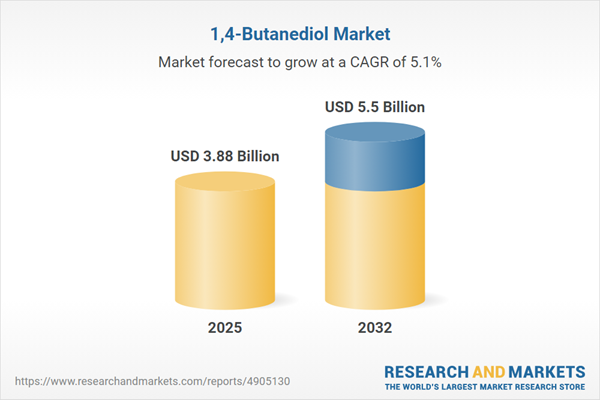Speak directly to the analyst to clarify any post sales queries you may have.
The 1,4-Butanediol market is evolving rapidly, propelled by innovation in chemical processes, shifting sustainability demands, and regulatory pressures. Senior executives need a clear understanding of the trends and disruptions shaping this vital sector to drive resilient, forward-thinking strategies.
Market Snapshot: 1,4-Butanediol Market Growth and Dynamics
The 1,4-Butanediol market grew from USD 3.70 billion in 2024 to USD 3.88 billion in 2025 and is projected to continue expanding at a CAGR of 5.08%, reaching USD 5.50 billion by 2032.
This growth is linked to increasing industrial and pharmaceutical applications, as well as a global shift toward sustainable chemical solutions. Market dynamics remain influenced by evolving regulatory landscapes, trade developments, and advances in both synthetic and bio-based production technologies.Scope & Segmentation: Defining the 1,4-Butanediol Market
This comprehensive report analyzes the 1,4-Butanediol value chain, capturing key market dimensions:
- Applications: Gamma Butyrolactone, Tetrahydrofuran.
- End-Use Industries: Automotive, Coatings, Pharmaceuticals, Polymers (including Polyester Polyols, Spandex, Thermoplastic Polyurethane).
- Type: Bio Based, Petroleum Based.
- Production Processes: Chemical Synthesis, Fermentation.
- Distribution Channels: Direct Sales, Distributors.
- Geographical Coverage: Americas (North America, Latin America), Europe, Middle East & Africa, Asia-Pacific.
- Key Market Players: The Dow Chemical Company, Ascend Performance Materials LLC, BASF SE, LyondellBasell Industries N.V., LANXESS AG, Mitsubishi Chemical Holdings Corporation, Invista S.à r.l., Solvay S.A., Huntsman Corporation, DuPont de Nemours, Inc.
Key Takeaways: Strategic Insights for Decision-Makers
- 1,4-Butanediol’s unique chemical versatility supports essential roles across multiple industrial sectors, especially in polymer and solvent applications.
- Adoption of bio-based fermentation pathways is accelerating, aligning with global sustainability initiatives and creating new value chain opportunities.
- Technological advancements such as continuous flow reactors and advanced process control systems are improving process efficiency and supporting adaptive manufacturing.
- Collaborations between chemical producers, biotechnology firms, and equipment suppliers are fostering innovation, especially for bio-derived variants.
- Regional strategies are shaped by regulatory regimes, logistics infrastructure, and feedstock accessibility, driving varied growth patterns across the Americas, EMEA, and Asia-Pacific.
Tariff Impact: Navigating Regulatory Shifts in 2025
Recently introduced United States tariffs on chemical intermediates have affected the cost structure throughout the 1,4-Butanediol market. These measures prompted downstream industries to realign sourcing strategies and accelerate domestic and regional production investments. The resulting supply chain adjustments have reinforced the importance of operational flexibility and collaborative approaches to secure a resilient market position.
Methodology & Data Sources
This report employs robust market research methodologies, integrating primary interviews with industry leaders and secondary review of technical, academic, and regulatory sources. Layered data triangulation and validation ensure an accurate, unbiased analysis. Quality controls and expert peer review underpin every major finding presented.
Why This Report Matters
- Facilitates confident strategic planning in a market shaped by evolving technology, regulation, and global trade risks.
- Equips senior leaders with actionable analytics on market segmentation, technological shifts, and supply chain developments.
- Empowers stakeholders to benchmark their operations, assess growth opportunities, and anticipate regulatory impacts without overlooking critical detail.
Conclusion
The 1,4-Butanediol market is navigating a period of transformation as sustainability, technology, and global policies reshape commercial opportunities. This analysis provides a clear roadmap for senior leaders to position their organizations for success amid changing industry dynamics.
Additional Product Information:
- Purchase of this report includes 1 year online access with quarterly updates.
- This report can be updated on request. Please contact our Customer Experience team using the Ask a Question widget on our website.
Table of Contents
3. Executive Summary
4. Market Overview
7. Cumulative Impact of Artificial Intelligence 2025
Companies Mentioned
The companies profiled in this 1,4-Butanediol market report include:- The Dow Chemical Company
- Ascend Performance Materials LLC
- BASF SE
- LyondellBasell Industries N.V.
- LANXESS AG
- Mitsubishi Chemical Holdings Corporation
- Invista S.à r.l.
- Solvay S.A.
- Huntsman Corporation
- DuPont de Nemours, Inc.
Table Information
| Report Attribute | Details |
|---|---|
| No. of Pages | 190 |
| Published | October 2025 |
| Forecast Period | 2025 - 2032 |
| Estimated Market Value ( USD | $ 3.88 Billion |
| Forecasted Market Value ( USD | $ 5.5 Billion |
| Compound Annual Growth Rate | 5.0% |
| Regions Covered | Global |
| No. of Companies Mentioned | 11 |









